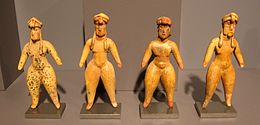Tlapacoya
Tlapacoya is an archaeological site in the municipality of Ixtapaluca in central Mexico .
location
The archaeological site of Tlapacoya is about 40 km southeast of the metropolis of Mexico City at an altitude of about 2300 m above sea level. d. M. The closest town is Ixtapaluca on the CF150 which runs from Mexico City to Puebla and on to Veracruz .
history
Prehistory
During the construction of the Mexico-Puebla motorway in 1966, the oldest traces of human activity in Central America to date were discovered at the foot of the former Tlapacoya volcano in the area of the former Lake Chalco . The artifacts, including scrapers and obsidian points , could be traced back to the time between 22,000 and 20,000 BC with the help of the C14 measurement and stratigraphic studies . To date. However, the results and methods are still highly controversial among those skilled in the art.
The dating of human skeletal remains to an age of 9730 ± 65 years is more secure, which means that the site would still have one of the earliest finds of human remains after the Buhl Woman .
Formative period
Small finds from around 1500–900 BC are just as important. Chr .; including several female clay figurines that make Olmec influences likely in their face and body treatment . From around 1000 BC Some of the drinking vessels or 'amphorae' (also known as dragon pots ) date from the 4th century BC , the style and motifs of which, according to several researchers, also reveal Olmec influences. The finds from Tlapacoya are also attributed to the so-called Tlatilco culture .
Archaeological site
Little remains of the archaeological site; the most important buildings date from the post-Christian era and were built into the slope of the former volcano Tlapacoya.
Remarks
- ↑ The information comes from Jose Luis Lorenzo and Lorena Mirambell, The Inhabitants of Mexico During the Upper Pleistocene, in: Ice Age People of North America, Eds. Robson Bonnichsen and Karen Turnmire, Oregon State University Press 1999, pp. 482–496. James Dixon, Bones, Boats & Bison, University of New Mexico Press 1999, considers the site unsafe.
See also
- Overview of the pre-Columbian ruins in Mexico (excluding Maya)
- Chronology of Pre-Columbian Mesoamerica
Coordinates: 19 ° 18 ′ 0 ″ N , 98 ° 55 ′ 0 ″ W.

